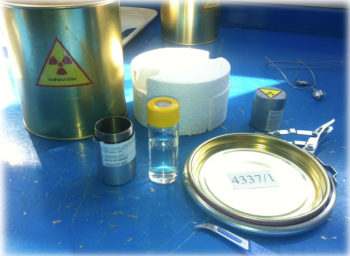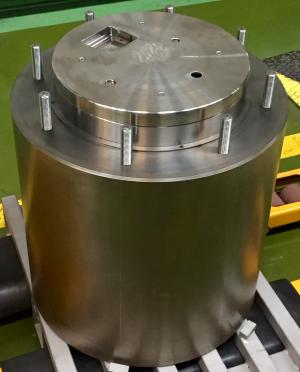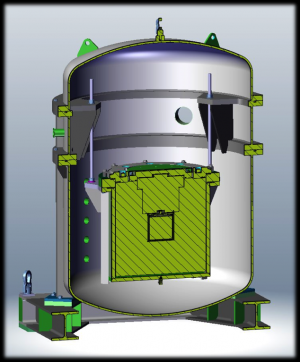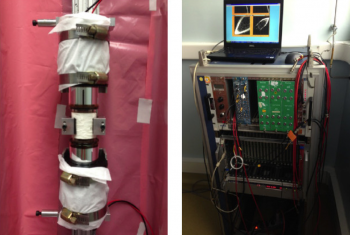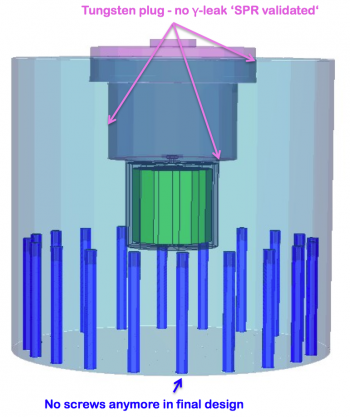Cerium Antineutrino Generator (CeANG) Production and Characterization:
In 2011 the CEA/DSM/Irfu group proposed to use an intense 144Ce-144Pr antineutrino generator to search for light sterile neutrinos in a large liquid scintillator detector (Phys.Rev.Lett. 107 (2011) 201801).
Since 2012 CEA and Mayak are closely working together to specify and realize the antineutrino generator. In 2014 INFN joined this effort. CEA has been in charge of preparing the commercial contract with PA Mayak.
CEA is specifically involved in the characterization of the CeANG through:
- Gamma spectroscopy
- Alpha spectroscopy (in collaboration with CEA Lase)
- Mass Spectroscopy (in collaboration with CEA Lase and Lenie)
High Density Tungsten Alloy Shielding:
144Ce is also gamma emitter and the CeANG will be placed inside a high-density tungsten alloy shield (HDTAS), that provides biological shielding during transportation and also biological shielding and background suppression during the data-taking period. The HDTAS has been designed by CEA/DRF/Irfu and is being procured by INFN and the University of Hawaï. Radiation dose simulation have been performed by the CEA/SPR and the dose will be less than 10 micro-Sievert per hour at 1 meter away.
CeANG Transportation:
CEA/DSM/Irfu and CEA/DEN/STMR are in charge of supervising the engineering of the CeSOX transportation, to be realized by the AREVA company. CEA is in charge of the commercial contracts with AREVA, funded by INFN.
Activity measurement: calorimetry
CEA/DSM/Irfu and CEA/DEN have been studying and designing a dedicated calorimeter to determine precisely the CeANG thermal heat release. Combined with a precise measurement of the 144Ce-144Pr beta spectra, this calorimetric measurement will allow a determination of the CeANG activity with a precision of less than 1%.
144Ce - 144Pr Beta spectroscopy
A precise knowledge of the energetic shape of the antineutrinos emitted by the CeANG is mandatory. Indeed, the prediction of the neutrino rate relies on the 144Pr spectral shape. This measurement must be done with a few percents precision level with a beta spectrometer. A CeANG sample is placed inside a two pieces plastic scintillating emitting light coupled to PMTs. In order to reach the precision level required, a chemical separation of 144Pr from 144Ce is carried out. This measurement in done in collaboration with the CEA Laboratory National Henri Becquerel and the Technical University of Munich.
The CEA/Irfu group also developed a state-of-the-art theoretical model of both 144Ce and 144Pr electron and neutrino spectra.
Simulation and Analysis
The CEA Irfu group is involved in CeANG, shielding (HDTAS), and detector simulations, from the early designing phases of the CeLAND and CeSOX projects.
- Simulation of the CeANG activity and impurity content
- GEANT4 and Tripoli-4 simulations of the HDTAS gamma ray and neutron attenuations
- Radiation dose computations, in collaboration with the CEA/SPR
- GEANT4 and Tripoli-4 simulations of the CeANG induced backgrounds (neutrons, gammas)
- Sensitivity and discovery potential computations
Main results are summarized in Phys.Rev. D91 (2015) 7, 072005.
Legal Authorizations:
An ancillary but crucial and substantial activity is also the preparation of the documentation that is required to obtain all authorizations to deploy the CeANG at LNGS. CEA is in charge of the following authorization files:
- CeANG importation in France
- CeANG exportation to Italy
- CeANG temporary storage at CEA
Authorization for transportations are being handled by AREVA, under the supervision of both CEA DSM/Irfu and DEN.
All french request are submitted to ASN, and technically analyzed by IRSN when necessary.

